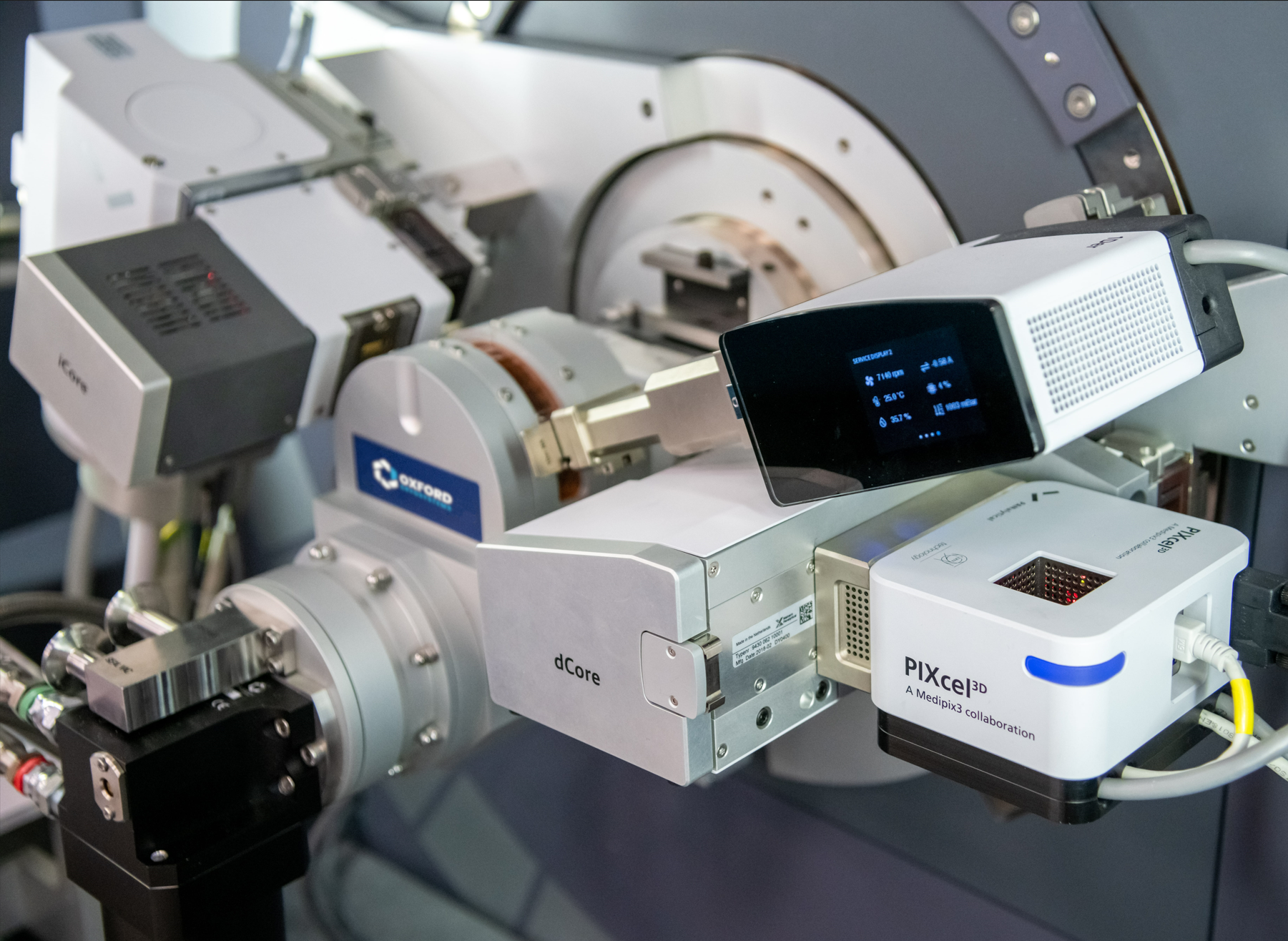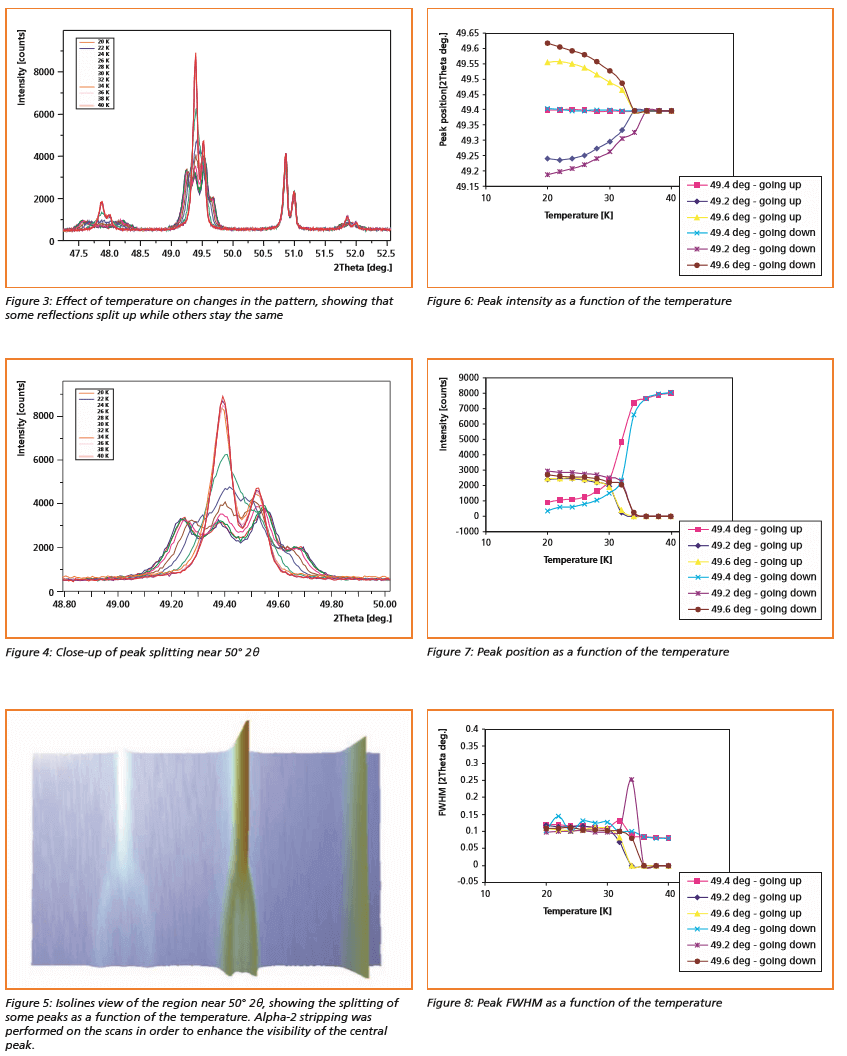The closed-cycle helium cryostat for X-ray powder diffraction applications was evaluated for temperature accuracy. Two methods were used to test the cryostat: thermal expansion and phase transition, and both methods confirmed the instrument’s accuracy and its suitability for low temperature powder diffraction. The PheniX cryostat is a valuable extension to the non-ambient capabilities of the Empyrean diffractometer.
The Phenix from Oxford Cryosystems is a closed-cycle helium powder cryostat. Designed for cooling flat-plate powder samples, the PheniX enables data collection close to liquid helium temperatures and combines fast cooldown and warm-up times with ease of use. The PheniX is equipped with a closed-cycle cryostat; a continuous supply of liquid helium is not required. It can be used to conduct X-ray powder diffraction experiments on θ-θ and θ-2θ type systems.
The Phenix from Oxford Cryosystems is a closed-cycle helium powder cryostat. Designed for cooling flat-plate powder samples, the PheniX enables data collection close to liquid helium temperatures and combines fast cool- down and warm-up times with ease of use. The PheniX is equipped with a closed-cycle cryostat; a continuous supply of liquid helium is not required. It can be used to conduct X-ray powder diffraction experiments on θ-θ and θ-2θ type systems.
With the PheniX it is possible to work at a temperature of 20 K in just 35 minutes from start-up, and as low as 12 K after a further 25 minutes. Sample changing is very fast as the PheniX has a warm-up time of just 40 minutes.
The temperature-induced sample displacement error is compensated automatically with the computer- controlled z-stage, yielding accurate diffractograms also in the parafocusing geometry.
Modern non-ambient devices, including the PheniX cryostat, are much easier to use than their predecessors. Most of these instruments also perform much better in terms of accuracy of the temperature readout – a very important issue.
The experiments described below were designed to test whether the PheniX with its low temperature limit can operate at a similarly high level of accuracy.
The closed-cycle helium cryostat for X-ray powder diffraction applications was evaluated for temperature accuracy. Two methods were used to test the cryostat: thermal expansion and phase transition, and both methods confirmed the instrument’s accuracy and its suitability for low temperature powder diffraction. The PheniX cryostat is a valuable extension to the non-ambient capabilities of the Empyrean diffractometer.

One method of evaluating the temperature accuracy of a non-ambient device is by determining the coefficient of thermal expansion (CTE) as a function of temperature. For the PheniX this was done by measuring the d-spacing of the (111) reflection of the aluminium sample holder at temperatures ranging from 20 K to room temperature, in steps of 20 K. The CTE at a given temperature T was calculated from d as follows:
Before each measurement, the sample position was optimized by determining the height at which the sample bisected the beam from the X-ray tube. This made it possible to measure the sample displacement as a function of temperature (Figure 1). This data was used for calibrating the auto- compensating z-stage.
The experimental results shown in Figure 2 agree well with the literature values for aluminium [1].
Figure 1: Sample displacement plotted as a function of the temperature. At the lowest temperatures there is only very little sample displacement visible.
Figure 2: Coefficient of thermal expansion plotted as a function of the temperature
Another common method of calibrating a non-ambient chamber is observation of known phase transitions. Unlike the CTE method, which gives a relative calibration over a large temperature range, a phase transition yields an absolute, one-point calibration. TbVO4 was used for this study because it has a well- characterized second-order phase transition at 33 K [2,3]. Diffractograms of TbVO4 powder were collected from 46 K down to 20 K, and back to 46 K, in steps of 2 K. The scan range was from 15° 2θ to 85° 2θ. Eight scans of ten minutes duration each were recorded at every temperature. By this method it was possible to confirm that the phase transition was not a slow process: at all steps, all eight scans were equal.
From observation of the region near 50° 2θ in Figures 3, 4 and 5, it is clear that some peaks are split, while others remain unaffected. Note that the phase transition does not take place at a particular temperature; it starts between 34 K and 32 K and gradually changes until it settles near 20 K. In order to evaluate the behavior of the phase transition in more detail, the region near 50° 2θ was analyzed with a profile fitting program (ProFit). The peaks were fit using a Pearson VII function. The results are summarized graphically in Figures 6, 7 and 8.
This study shows that:

The experiments in this application note were carried out on an Empyrean diffractometer, equipped with programmable slits and an X’Celerator detector.
Benefits
The PheniX cryostat from Oxford Cryosystems has many features that make low-temperature powder diffraction much easier:
Both the thermal expansion measurements and the phase transition determination confirm the temperature accuracy of the Oxford PheniX cryostat. The combination of a closed-cycle, computer-controlled cryostat with a PreFIX interface to the goniometer, makes this low-temperature device an easy-to-use addition to the Empyrean. It does not restrict the flexibility of a modern modular instrument in any way. The system’s ease of use makes it ideal for users without prior experience in cryogenic techniques.
The TbVO4 example demonstrates the possibility to observe subtle structural changes with a powder diffractometer. These details allow a valuable insight in the properties of advanced materials.
We would like to thank Dr. B. Pilawa, University of Karlsruhe, Germany for the TbVO4 sample used in this study.
[1] F C Nix, D MacNair, Physical Review, v60, p597 (1941) and D F Gibbons, Physical Review, v112, p136 (1958), found in the Materials Properties DataBase (MPDB) v5.35 - demo, Copyright © 1999 by JAHM Software, Inc. All rights reserved. Web site: http://www.jahm.com. There is a free demo version of this database that contains many physical properties of the pure elements, including the original references.
[2] K Kirschbaum et al, (1999), Cooperative Jahn-Teller induced phase transition of TbVO4: single crystal structure analyses of the tetragonal high temperature phase and the twinned orthorhombic phase below 33 K, Journal of Physics: Condensed Matter, 11, pp 4483-4490.
[3] H Fuess and A Kallel, (1972), Refinement of the Crystal Structure of some Rare Earth Vanadates RVO4 (R = Dy, Tb, Ho, Yb), Journal of Solid State Chemistry, 5, pp 11-14.